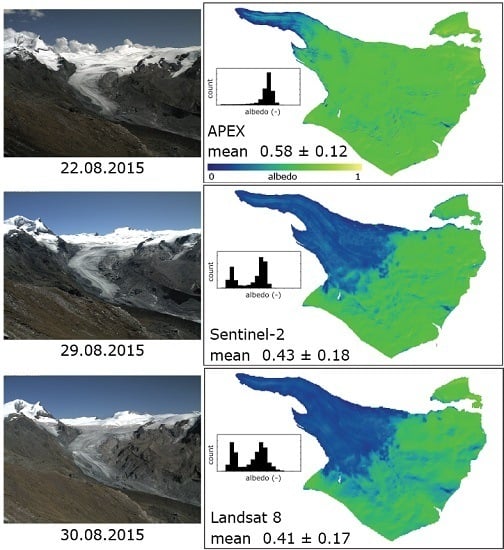Cross-Comparison of Albedo Products for Glacier Surfaces Derived from Airborne and Satellite (Sentinel-2 and Landsat 8) Optical Data
Abstract
:1. Introduction
2. Study Site and Data
2.1. Airborne Prism EXperiment (APEX)
2.2. Sentinel-2 (S2)
2.3. Landsat 8 (L8)
2.4. ASD Field Spectrometer
2.5. CM7B Albedometer/CNR4 Net Radiometer
2.6. Digital Elevation Models
2.7. Weather Situation between Acquisition Times of Datasets
3. Methods
3.1. Anisotropy-Corrected Shortwave Broadband Albedo
Reflectance Anisotropy Correction
3.2. Resampling of APEX Data to Simulate Sentinel-2 and Landsat 8
3.3. Narrow-to-Broadband Conversion
3.4. Pre-Processing of Different Datasets
3.4.1. Vicarious Calibration
3.4.2. Cloud Removal
3.5. Experimental Setup
4. Results
4.1. Impact of Spectral and Spatial Resolution (Experiment 1)
4.2. Impact of Environmental Factors on Albedo Products across Datasets (Experiment 2)
4.3. Impact of Narrow-to-Broadband Conversion (Experiment 3)
4.4. Impact of Anisotropy Correction (Experiment 4)
4.5. Validation
5. Discussion
5.1. Satellite-Based Glacier Surface Albedo Monitoring
Impact of Spectral and Spatial Resolution
5.2. Further Considerations for the Use of Optical Data for Glacier Surface Albedo Monitoring
5.2.1. Impact of Environmental Factors on Glacier Albedo
5.2.2. Impact of Narrow-to-Broadband Conversion
5.2.3. Impact of Surface Anisotropy
6. Conclusions
- ■
- We highlight that a decreasing spectral resolution more strongly impacts shortwave albedo retrievals as compared to coarsening spatial resolution. However, a coarser spatial resolution is not capable of capturing the small-scale heterogeneity of bare-ice glacier surfaces that modulate melt processes locally. We suggest using remote sensing data with intermediate (20–30 m) to high (~2 m) ground-sampling distance to reproduce the spatial variability of glacier surface albedo for mountain glaciers in complex terrain.
- ■
- We found substantial variation of shortwave broadband albedo over glacier surfaces based on weather and environmental factors and suggest establishing satellite-based monitoring capability to track these substantial spatio-temporal changes and eventually advance predictions of actual and future glacier melt under global climate change.
- ■
- We evaluated the effect of narrow-to-broadband albedo conversions, needing to be applied to satellite data for albedo monitoring, and found the impact negligible compared to the added value that would be provided by a dedicated satellite-based albedo monitoring.
- ■
- We found a surface material-specific impact of reflectance anisotropy on the retrieval of glacier albedo and suggest accounting for this effect.
Acknowledgments
Author Contributions
Conflicts of Interest
Appendix A
A1. Weather Situation between Acquisition Times of Datasets–Camera Images


A2. Pre-Processing of Different Datasets–Vicarious Calibration
| Sensor | Findelengletscher | Glacier de la Plaine Morte |
|---|---|---|
| APEX | 17% | 13% |
| Sentinel-2 | 15% | 6% |
| Landsat 8 | 3% | 9% |
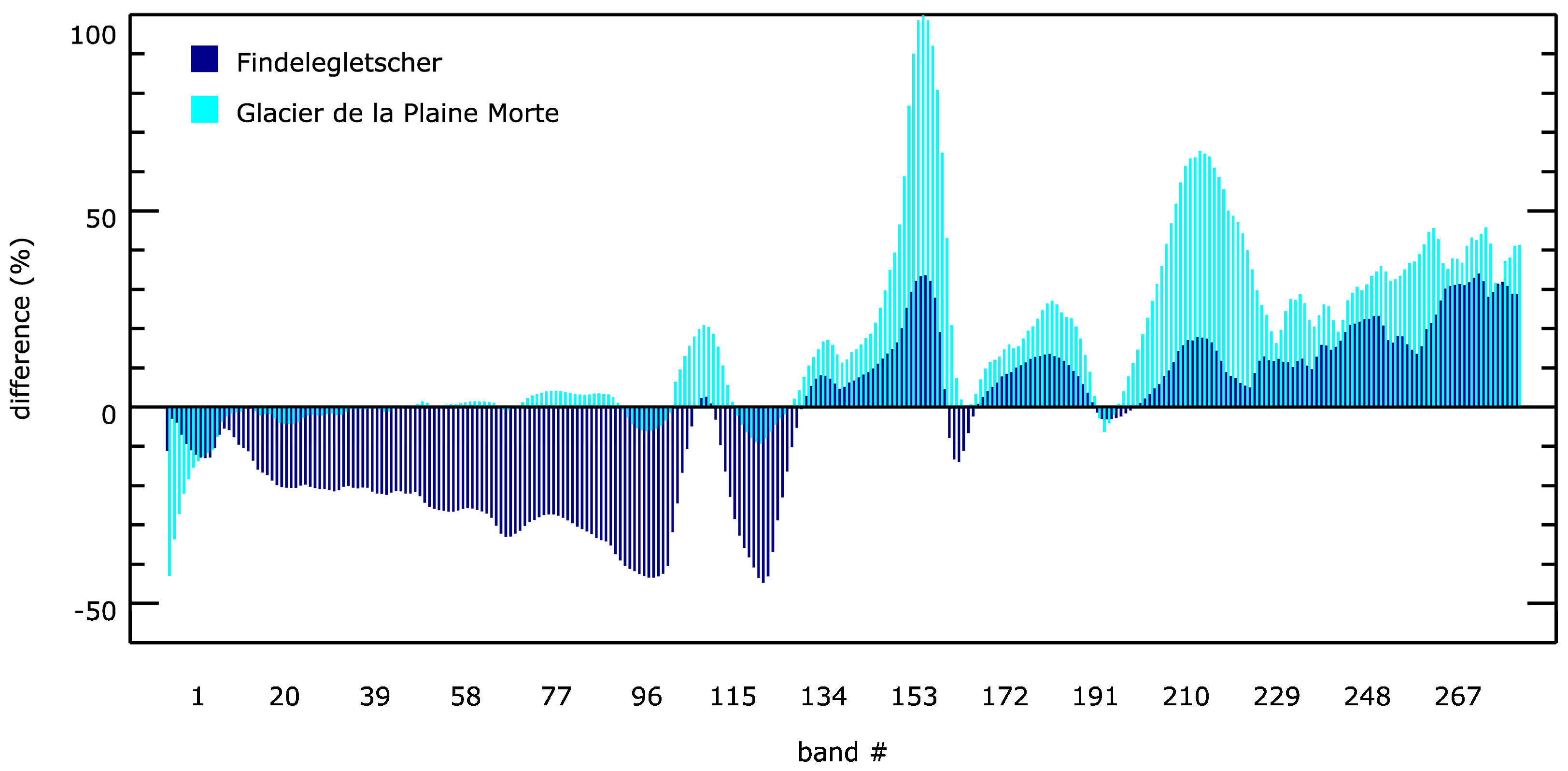
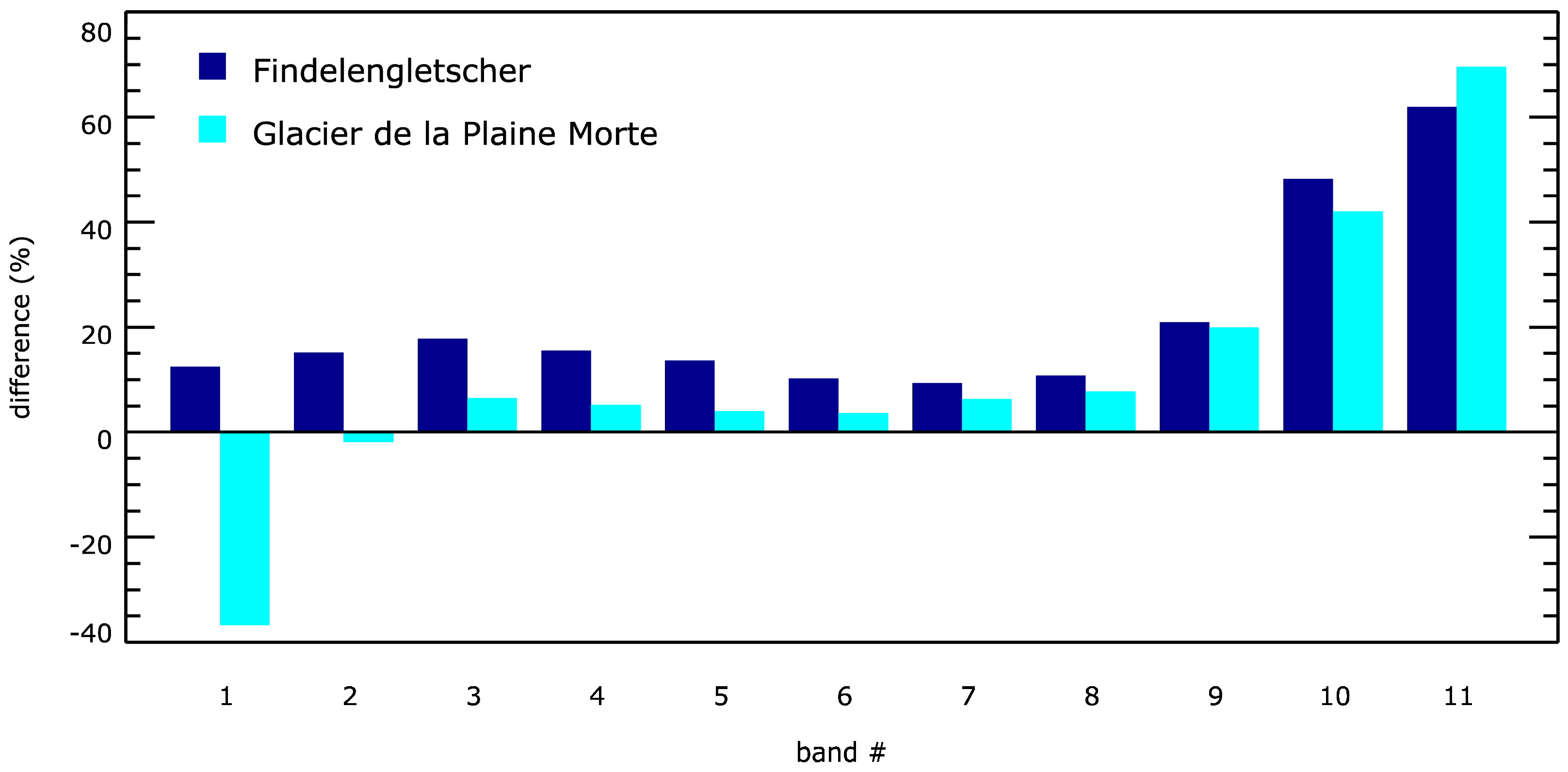
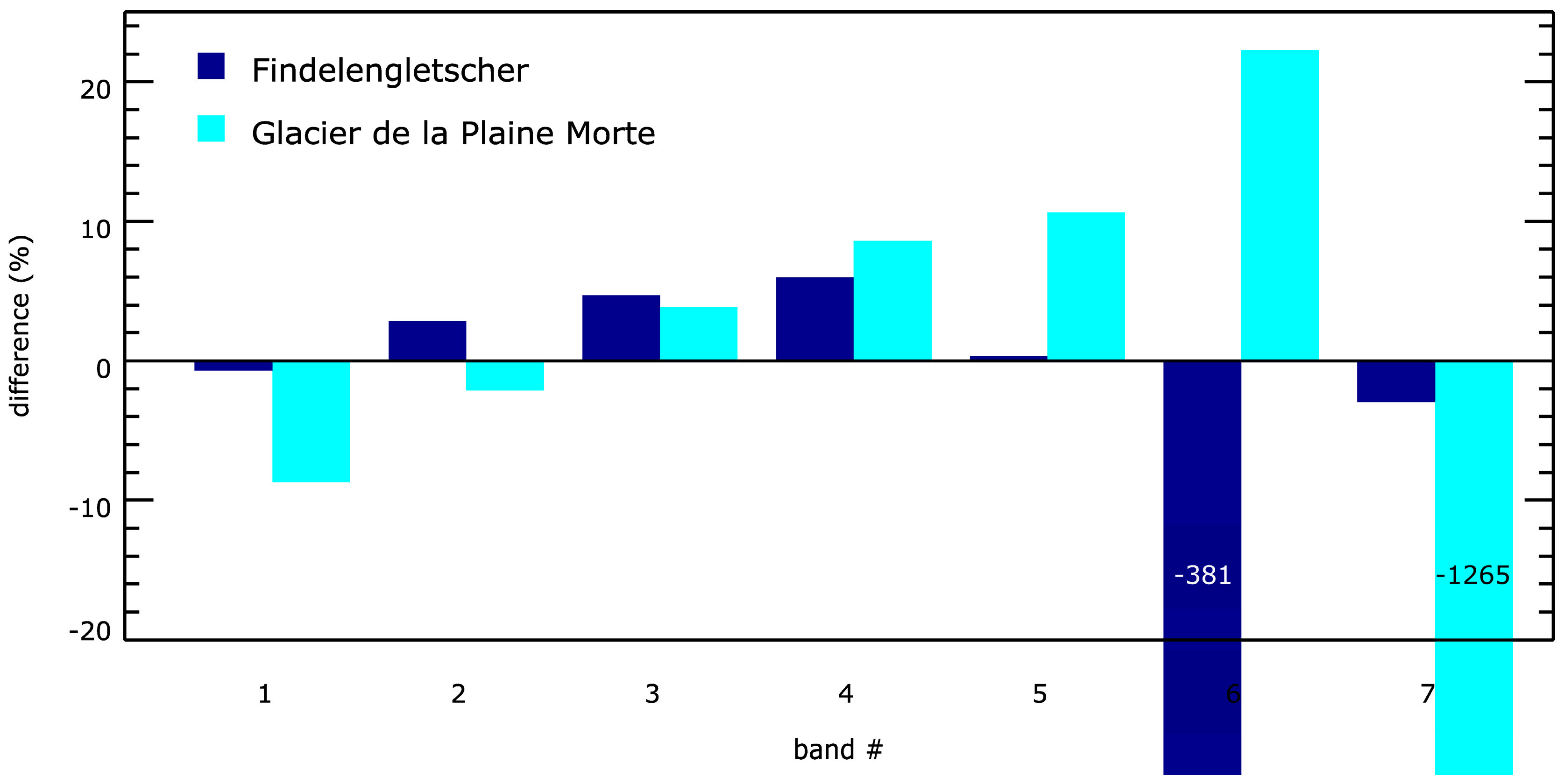
References
- Tedesco, M.; Doherty, S.; Fettweis, X.; Alexander, P.; Jeyaratnam, J.; Stroeve, J. The darkening of the Greenland ice sheet: Trends, drivers, and projections (1981–2100). Cryosphere 2016, 10, 477–496. [Google Scholar] [CrossRef]
- Brun, F.; Dumont, M.; Wagnon, P.; Berthier, E.; Azam, M.F.; Shea, J.M.; Sirguey, P.; Rabatel, A.; Ramanathan, A. Seasonal changes in surface albedo of Himalayan glaciers from MODIS data and links with the annual mass balance. Cryosphere 2015, 9, 341–355. [Google Scholar] [CrossRef]
- Alexander, P.M.; Tedesco, M.; Fettweis, X.; van de Wal, R.S.W.; Smeets, C.J.P.P.; van den Broeke, M.R. Assessing spatio-temporal variability and trends in modelled and measured Greenland Ice Sheet albedo (2000–2013). Cryosphere 2014, 8, 2293–2312. [Google Scholar] [CrossRef]
- Box, J.E.; Fettweis, X.; Stroeve, J.C.; Tedesco, M.; Hall, D.K.; Steffen, K. Greenland ice sheet albedo feedback: Thermodynamics and atmospheric drivers. Cryosphere 2012, 6, 821–839. [Google Scholar] [CrossRef]
- Cuffey, K.M.; Paterson, W.S.B. The Physics of Glaciers, 4th ed.; Butterworth-Heinemann: Oxford, UK, 2010. [Google Scholar]
- Pope, A.; Rees, G.W. Impact of spatial, spectral, and radiometric properties of multispectral imagers on glacier surface classification. Remote Sens. Environ. 2014, 141, 1–13. [Google Scholar] [CrossRef]
- Nolin, A.W.; Payne, M.C. Classification of glacier zones in western Greenland using albedo and surfaceroughness from the Multi-angle Imaging SpectroRadiometer (MISR). Remote Sens. Environ. 2007, 107, 264–275. [Google Scholar] [CrossRef]
- Klein, A.G.; Isacks, B.L. Spectral mixture analysis of Landsat thematic mapper images applied to the detection of the transient snowline on tropical Andean glaciers. Glob. Planet. Chang. 1999, 22, 139–154. [Google Scholar] [CrossRef]
- Hock, R. Glacier melt: A review of processes and their modelling. Prog. Phys. Geogr. 2005, 29, 362–391. [Google Scholar] [CrossRef]
- Oerlemans, J.; Giesen, R.H.; Van Den Broeke, M.R. Retreating alpine glaciers: Increased melt rates due to accumulation of dust (Vadret da Morteratsch, Switzerland). J. Glaciol. 2009, 55, 729–736. [Google Scholar] [CrossRef]
- Takeuchi, N. Structure, Formation, and Darkening Process of Albedo-reducing Material (Cryoconite) on a Himalayan Glacier: A Granular Algal Mat Growing on the Glacier. Arctic Antarct. Alp. Res. 2001, 33, 115–122. [Google Scholar] [CrossRef]
- Lutz, S.; Anesio, A.M.; Villar, S.E.J.; Benning, L.G. Variations of algal communities cause darkening of a Greenland glacier. Fed. Eur. Microbiol. Soc. 2014, 89, 402–414. [Google Scholar] [CrossRef] [PubMed]
- Cook, J.; Edwards, A.; Takeuchi, N.; Irvine-Fynn, T. Cryoconite: The dark biological secret of the cryosphere. Prog. Phys. Geogr. 2016, 40, 66–111. [Google Scholar] [CrossRef]
- Wang, J.; Ye, B.; Cui, Y.; He, X.; Yang, G. Spatial and temporal variations of albedo on nine glaciers in western China from 2000 to 2011. Hydrol. Process. 2014, 28, 3454–3465. [Google Scholar] [CrossRef]
- Jonsell, U.; Hock, R.; Holmgren, B. Spatial and temporal variations in albedo on Storglaciären, Sweden. J. Glaciol. 2003, 49, 59–68. [Google Scholar] [CrossRef]
- Dumont, M.; Sirguey, P.; Arnaud, Y.; Six, D. Monitoring spatial and temporal variations of surface albedo on Saint Sorlin Glacier (French Alps) using terrestrial photography. Cryosphere 2011, 5, 759–771. [Google Scholar] [CrossRef]
- Paul, F.; Kotlarski, S. Forcing a distributed mass balance model with the regional climate model REMO, Part II: Downscaling strategy and results for two Swiss glaciers. J. Clim. 2010, 23, 1607–1620. [Google Scholar] [CrossRef]
- Paul, F.; Machguth, H.; Hoelzle, M.; Salzmann, N.; Haeberli, W. Alpine-wide distributed glacier mass balance modelling: A tool for assessing future glacier change? In Darkening Peaks: Glacier Retreat, Science, and Society; Orlove, B., Wiegandt, E., Luckman, B., Eds.; University of California Press: Berkeley, CA, USA, 2008; pp. 111–125. [Google Scholar]
- Machguth, H.; Paul, F.; Hoelzle, M.; Haeberli, W. Distributed glacier mass balance modelling as an important component of modern multi-level glacier monitoring. Ann. Glaciol. 2006, 43, 335–343. [Google Scholar] [CrossRef]
- Paul, F.; Machguth, H.; Kääb, A. On the impact of glacier albedo under conditions of extreme glacier melt: The summer of 2003 in the Alps. EARSeL eProc. 2005, 4, 139–149. [Google Scholar]
- Fugazza, D.; Senese, A.; Azzoni, R.S.; Maugeri, M.; Diolaiuti, G.A. Distribution of surface albedo at the Forni Glacier (Stelvio National Park, Central Italian Alps). Cold Reg. Sci. Technol. 2016, 125, 128–137. [Google Scholar] [CrossRef]
- Pope, E.L.; Willis, I.C.; Pope, A.; Miles, E.S.; Arnold, N.S.; Rees, W.G. Contrasting snow and ice albedos derived from MODIS, Landsat ETM+ and airborne data from Langjökull, Iceland. Remote Sens. Environ. 2016, 175, 183–195. [Google Scholar] [CrossRef]
- Knap, W.H.; Brock, B.W.; Oerlemans, J.; Willis, I.C. Comparison of Landsat TM- derived and ground-based albedos of Haut Glacier d’Arolla, Switzerland. Int. J. Remote Sens. 1999, 20, 3293–3310. [Google Scholar] [CrossRef]
- Dumont, M.; Gardelle, J.; Sirguey, P.; Guillot, A.; Six, D.; Rabatel, A.; Arnaud, Y. Linking glacier annual mass balance and glacier albedo retrieved from MODIS data. Cryosphere 2012, 6, 1527–1539. [Google Scholar] [CrossRef]
- Dumont, M.; Brun, E.; Picard, G.; Michou, M.; Libois, Q.; Petit, J.-R.; Geyer, M.; Morin, S.; Josse, B. Contribution of light-absorbing impurities in snow to Greenland’s darkening since 2009. Nat. Geosci. 2014, 7, 509–512. [Google Scholar] [CrossRef]
- Cogley, G.J.; Hock, R.; Rasmussen, L.A.; Arendt, A.A.; Bauder, A.; Braithwaite, R.J.; Jansson, P.; Kaser, G.; Möller, M.; Nicholson, L.; et al. Glossary of Glacier Mass Balance and Related Terms; International Hydrological Programme (IHP) VII Technical Documents in Hydrology No. 86; UNESCO-IHP: Paris, France, 2011. [Google Scholar]
- Lucht, W.; Hyman, A.H.; Strahler, A.H.; Barnsley, M.J.; Hobson, P.; Muller, J. A Comparison of Satellite-Derived Spectral Albedos to Ground-Based Broadband Albedo Measurements Modeled to Satellite Spatial Scale for a Semidesert Landscape. Remote Sens. Environ. 2000, 74, 85–98. [Google Scholar] [CrossRef]
- Qu, Y.; Liang, S.; Liu, Q.; He, T.; Liu, S.; Li, X. Mapping surface broadband albedo from satellite observations: A review of literatures on algorithms and products. Remote Sens. 2015, 7, 990–1020. [Google Scholar] [CrossRef]
- Knap, W.H.; Reijmer, C.H.; Oerlemans, J. Narrowband to broadband conversion of Landsat TM glacier albedos. Int. J. Remote Sens. 1999, 20, 2091–2110. [Google Scholar] [CrossRef]
- Liang, S. Narrowband to broadband converions of land surface albedo: I Algorithms. Remote Sens. Environ. 2000, 76, 213–238. [Google Scholar] [CrossRef]
- Naegeli, K.; Huss, M.; Damm, A.; Schaepman, M.; Hoelzle, M. Imaging spectroscopy to assess the composition of ice surface materials and their impact on glacier mass balance. Remote Sens. Environ. 2015, 168, 388–402. [Google Scholar] [CrossRef]
- Joerg, P.C.; Weyermann, J.; Morsdorf, F.; Zemp, M.; Schaepman, M.E. Computation of a distributed glacier surface albedo proxy using airborne laser scanning intensity data and in-situ spectro-radiometric measurements. Remote Sens. Environ. 2015, 160, 31–42. [Google Scholar] [CrossRef]
- Schaepman-Strub, G.; Schaepman, M.E.; Painter, T.H.; Dangel, S.; Martonchik, J.V. Reflectance quantities in optical remote sensing—Definitions and case studies. Remote Sens. Environ. 2006, 103, 27–42. [Google Scholar] [CrossRef]
- Klok, E.J.L.; Greuell, W.; Oerlemans, J. Temporal and spatial variation of the surface albedo of Morteratschgletscher, Switzerland, as derived from 12 Landsat images. J. Glaciol. 2003, 49, 491–502. [Google Scholar] [CrossRef]
- Greuell, W.; de Ruyter de Wildt, M.S. Anisotropic reflection by melting glacier ice: Measurements and parametrizations in Landsat TM Bands 2 and 4. Remote Sens. Environ. 1999, 70, 265–277. [Google Scholar] [CrossRef]
- Winther, J. Spectral bi-directional reflectance of snow and glacier ice measured in Dronning Maud Land, Antarctica. Ann. Glaciol. 1994, 20, 1–5. [Google Scholar] [CrossRef]
- Yearbooks of the Cryospheric Commission of the Swiss Academy of Sciences (SCNAT); Glaciological Reports, The Swiss Glaciers, 2011/2012–2012/2013; VAW-ETH: Zürich, Switzerland, 2016; pp. 133–134. [CrossRef]
- Sold, L.; Huss, M.; Machguth, H.; Joerg, P.C.; Vieli, G.L.; Linsbauer, A.; Salzmann, N.; Zemp, M.; Hoelzle, M. Mass Balance Re-analysis of Findelengletscher, Switzerland; Benefits of Extensive Snow Accumulation Measurements. Front. Earth Sci. 2016, 4. [Google Scholar] [CrossRef]
- Huss, M.; Voinesco, A.; Hoelzle, M. Implications of climate change on Glacier de la Plaine Morte, Switzerland. Geogr. Helv. 2013, 68, 227–237. [Google Scholar] [CrossRef]
- Schaepman, M.E.; Jehle, M.; Hueni, A.; D’Odorico, P.; Damm, A.; Weyermann, J.; Schneider, F.D.; Laurent, V.; Popp, C.; Seidel, F.C.; et al. Advanced radiometry measurements and Earth science applications with the Airborne Prism Experiment (APEX). Remote Sens. Environ. 2015, 158, 207–219. [Google Scholar] [CrossRef]
- Jehle, M.; Hueni, A.; Damm, A.; D’Odorico, P.; Weyermann, J.; Kneubühler, M.; Schläpfer, D.; Schaepman, M.E. APEX—Current status, performance and validation concept. IEEE Sens. 2010, 2010, 533–537. [Google Scholar] [CrossRef]
- Hueni, A.; Lenhard, K.; Baumgartner, A.; Schaepman, M.E. Airborne Prism Experiment Calibration Information System. IEEE Trans. Geosci. Remote Sens. 2013, 51. [Google Scholar] [CrossRef]
- Schläpfer, D.; Richter, R. Geo-atmospheric processing of airborne imaging spectrometry data. Part 1: Parametric orthorectification. Int. J. Remote Sens. 2002, 23, 2609–2630. [Google Scholar] [CrossRef]
- Richter, R.; Schläpfer, D. Geo-atmospheric processing of airborne imaging spectrometry data. Part 2: Atmospheric/topographic correction. Int. J. Remote Sens. 2002, 23, 2631–2649. [Google Scholar] [CrossRef]
- Vermote, E.; Justice, C.; Claverie, M.; Franch, B. Preliminary analysis of the performance of the Landsat 8/OLI land surface reflectance product. Remote Sens. Environ. 2016, 185, 46–56. [Google Scholar] [CrossRef]
- Swisstopo swissALTI3d Ausgabebericht 2015; Eidgenössisches Departement für Verteidigung, Bevölkerungsschutz und Sport, VBS, Wabern. 2015.
- Pellikka, P.; Rees, W.G. Remote Sensing of Glaciers; Taylor & Francis Group: London, UK, 2010. [Google Scholar]
- Henderson-Sellers, A.; Wilson, M.F. Surface Albedo Data for Climatic Modeling. Rev. Geophys. Sp. Phys. 1983, 21, 1743–1778. [Google Scholar] [CrossRef]
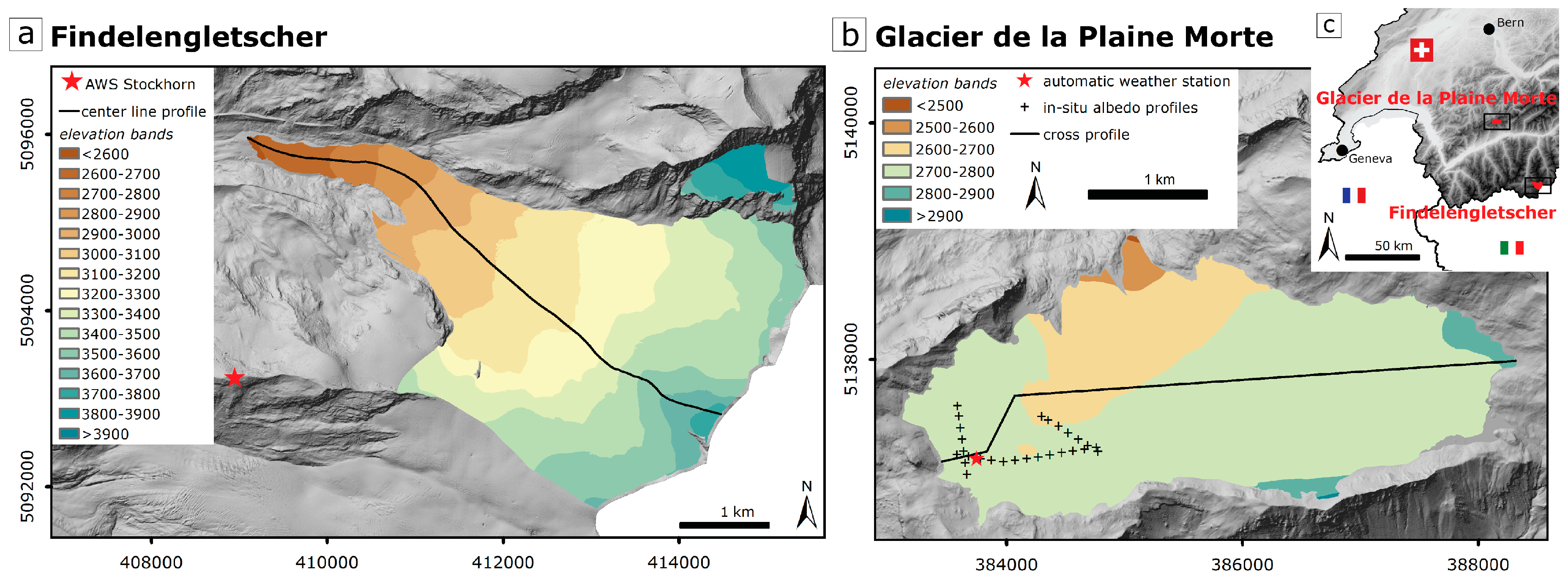
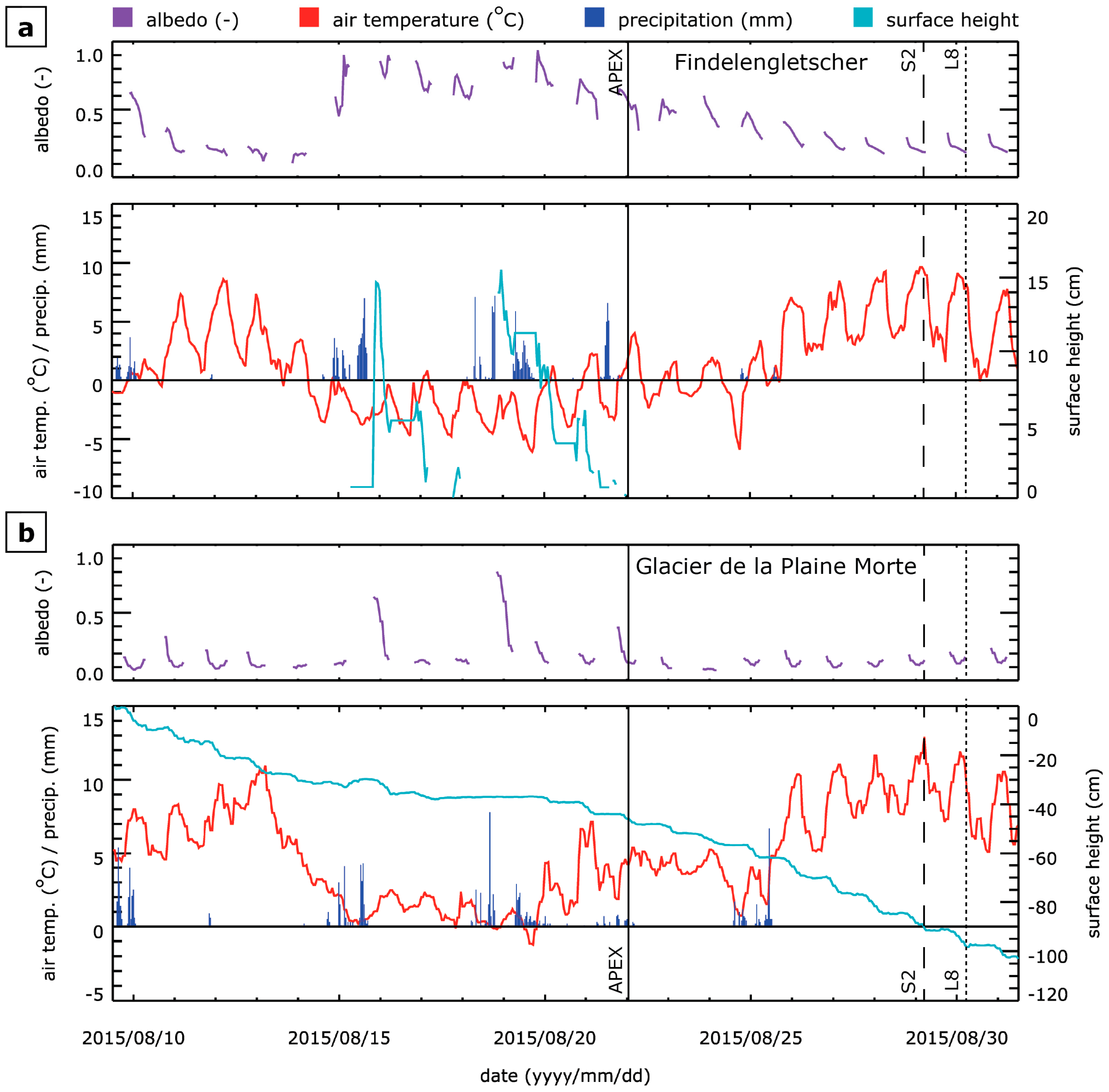
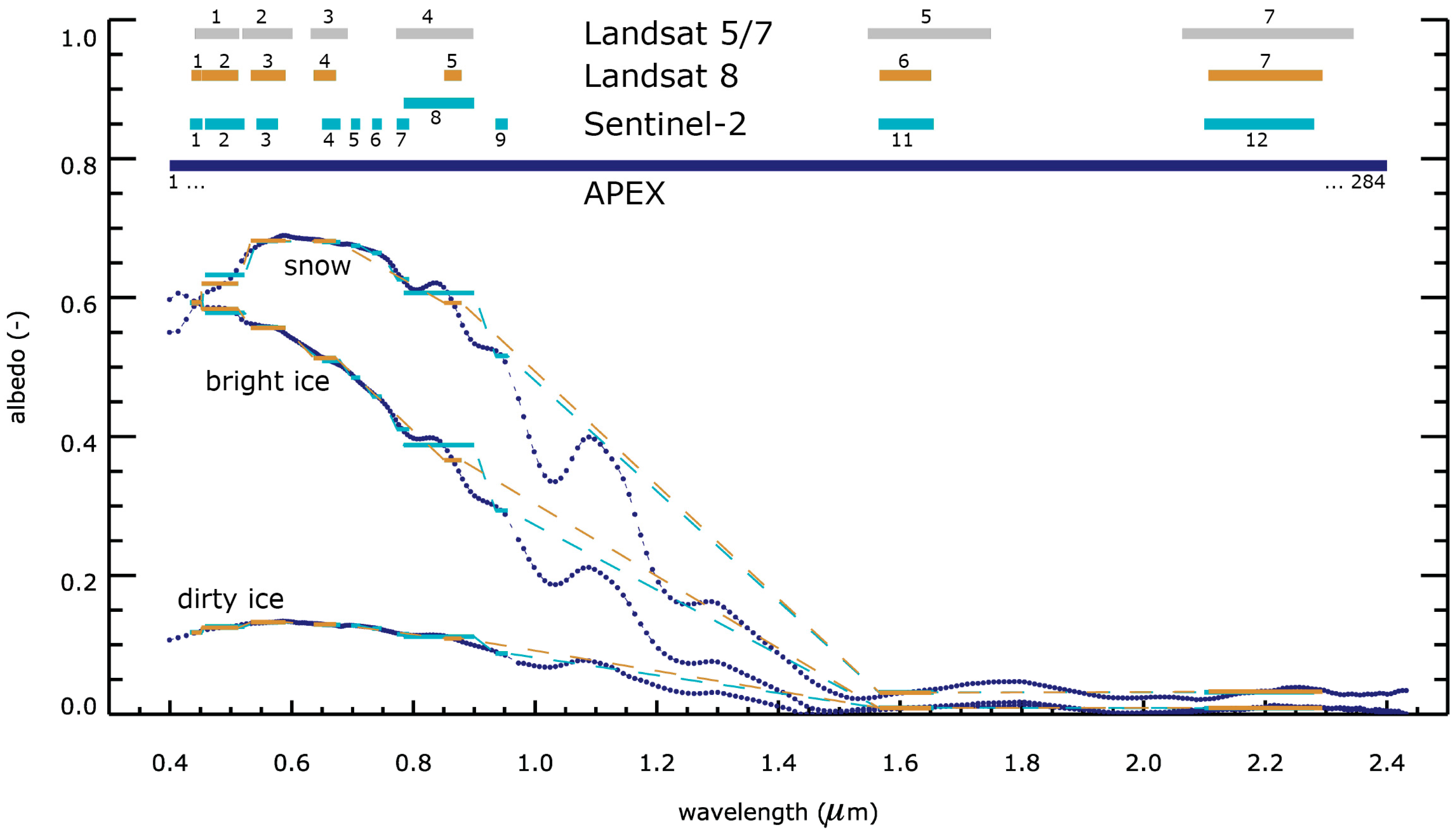
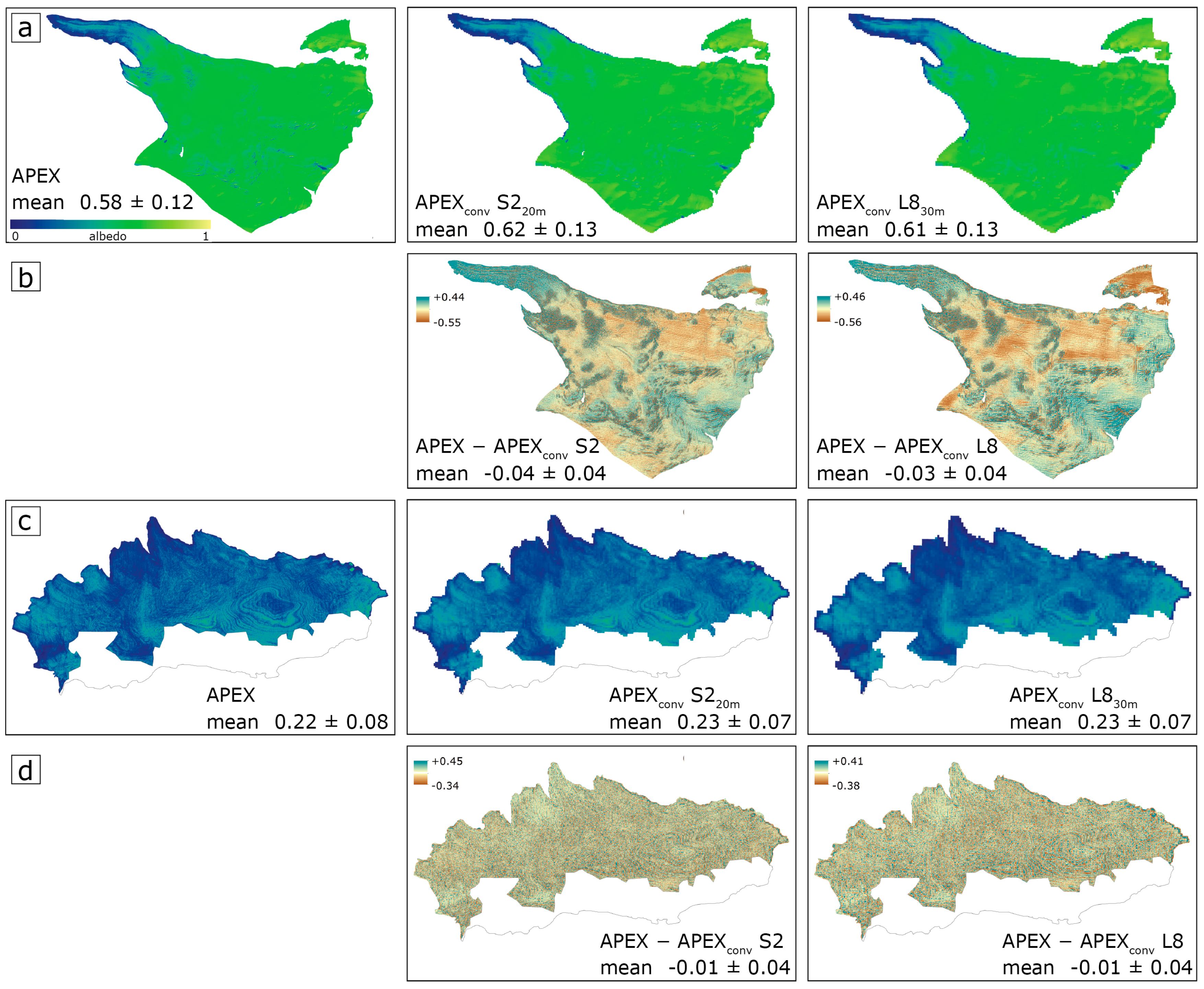
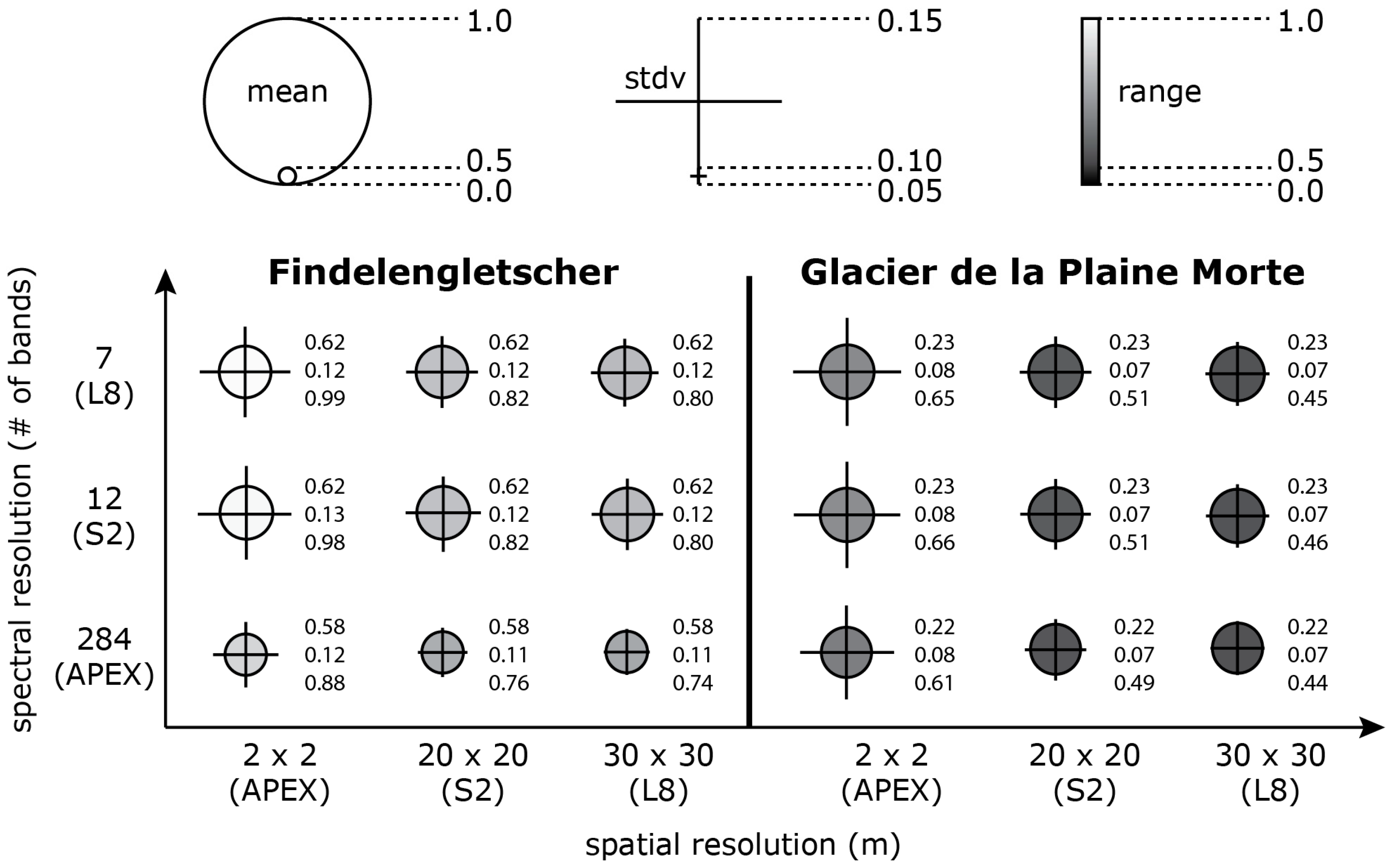
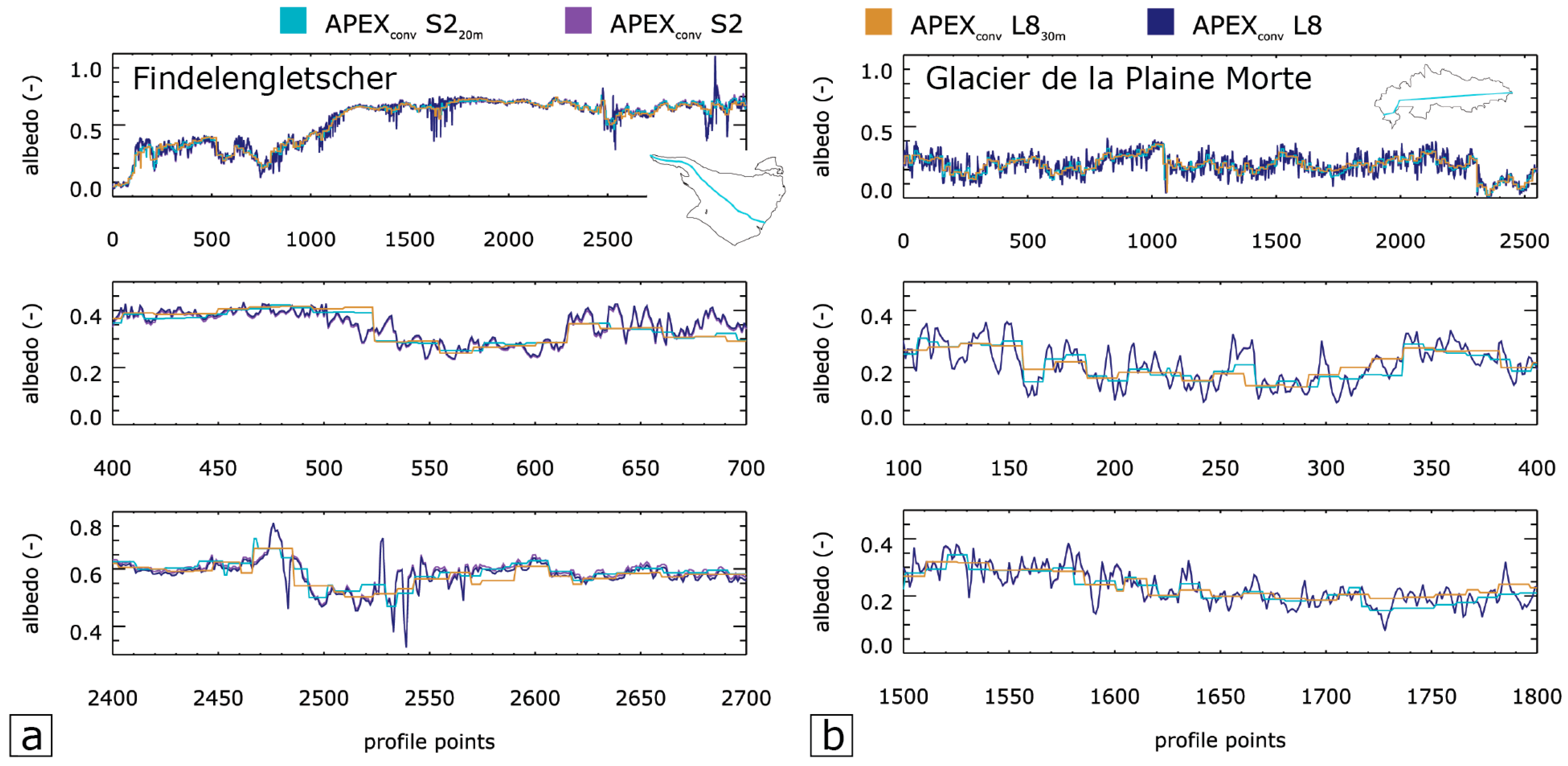
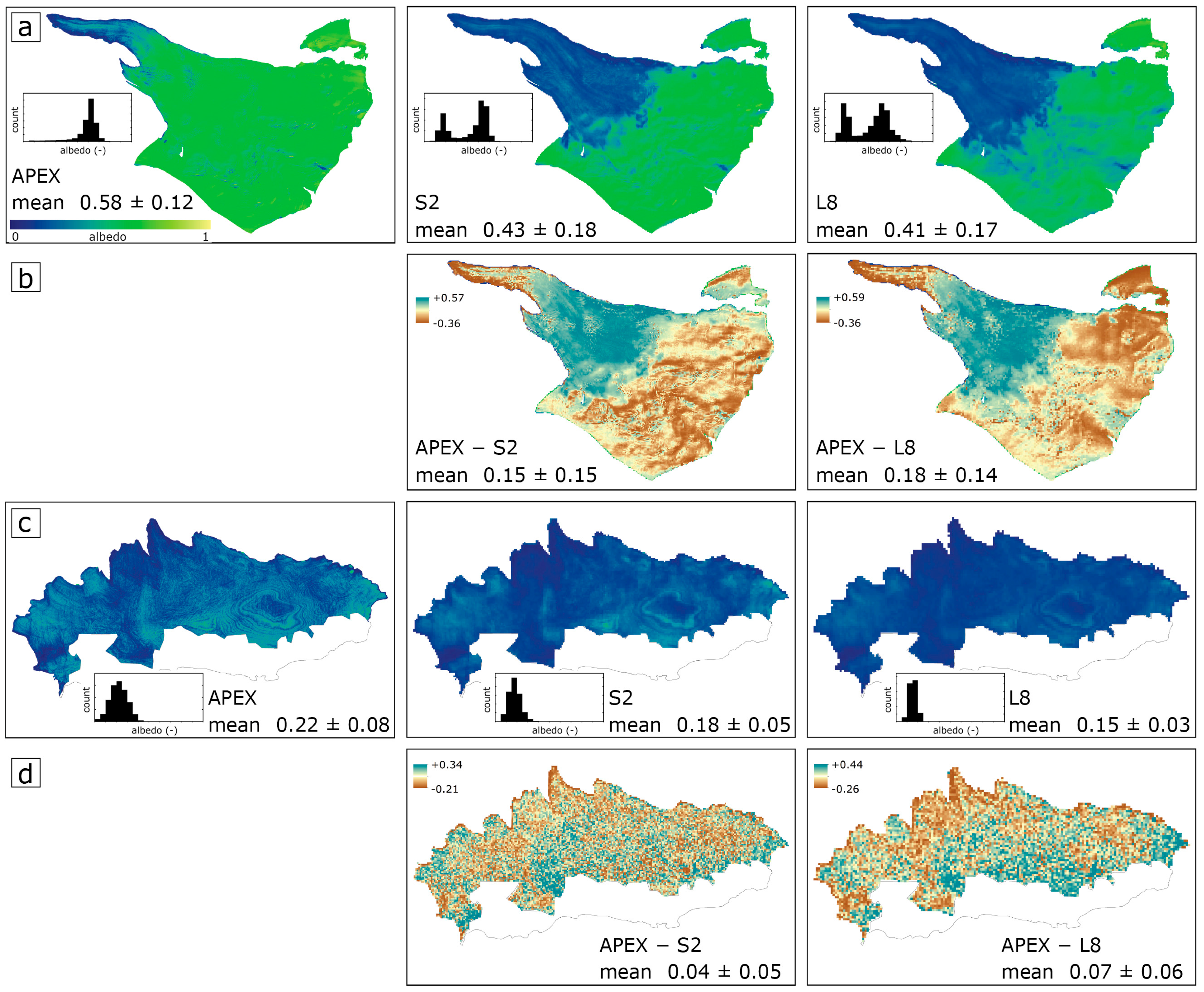
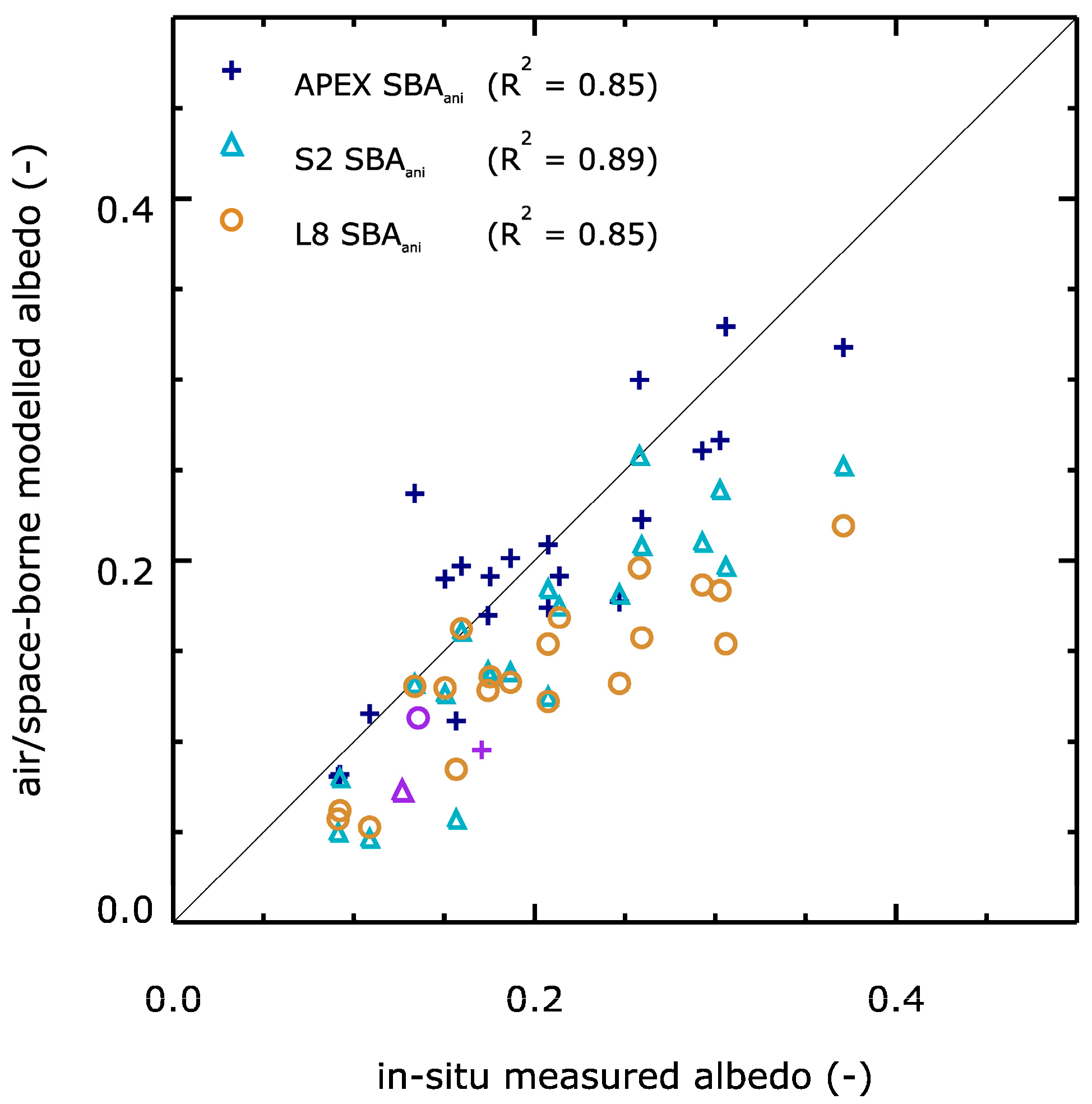
| Sensor | Acquisition Date | Number of Bands | Spectral Range | Ground-Sampling Distance |
|---|---|---|---|---|
| APEX | 22 August 2015 | 284 | 0.38–2.50 μm | 2 m |
| Sentinel-2 | 29 August 2015 | 11 | 0.45–2.28 μm | 20 m (on average) |
| Landsat 8 | 30 August 2015 | 7 | 0.43–2.29 μm | 30 m |
| ASD field spectrometer | 11 September 2014 | 2151 | 0.35–2.50 μm | 0.6 m |
| 31 August 2013 | ||||
| CM7B albedometer | Various days summer 2014 | - | 0.31–2.8 μm | - |
| CNR4 net radiometer | Continuous (July 3–15 October 2015) | - | 0.30–2.8 µm (short wave) | - |
| 4.50–42 µm (long wave) |
| Statistics | Findelengletscher | |||||
| APEX | S2 | L8 | Average Overall Variation | Sensor Impact (Deduced from Experiment 1) | Environmental Impact | |
| min | 0.00 | 0.08 | 0.08 | 0.08 | 0.07 | 0.01 |
| max | 0.88 | 0.78 | 0.79 | −0.15 | −0.03 | −0.12 |
| mean | 0.58 | 0.43 | 0.41 | −0.16 | 0.04 | −0.20 |
| std | 0.12 | 0.18 | 0.17 | 0.06 | 0.01 | 0.05 |
| Statistics | Glacier de la Plaine Morte | |||||
| APEX | S2 | L8 | Average Overall Variation | Sensor Impact | Environmental Impact | |
| min | 0.00 | 0.03 | 0.04 | 0.04 | 0.04 | 0.00 |
| max | 0.61 | 0.44 | 0.31 | −0.24 | −0.05 | −0.19 |
| mean | 0.22 | 0.18 | 0.15 | −0.06 | 0.01 | −0.07 |
| std | 0.08 | 0.05 | 0.03 | −0.05 | −0.01 | −0.04 |
| Statistics | Findelengletscher | |||||
| APEXKnap | APEXLiang | S2Knap | S2Liang | L8Knap | L8Liang | |
| min | −0.02 | −0.05 | 0.06 | 0.08 | 0.06 | 0.08 |
| max | 1.31 | 0.86 | 0.75 | 0.78 | 0.80 | 1.22 |
| mean | 0.69 | 0.58 | 0.40 | 0.43 | 0.37 | 0.41 |
| std | 0.17 | 0.11 | 0.17 | 0.18 | 0.17 | 0.18 |
| % > 1 | 0.2% | 0% | 0% | 0% | 0% | 0.01% |
| Statistics | Glacier de la Plaine Morte | |||||
| APEXKnap | APEXLiang | S2Knap | S2Liang | L8Knap | L8Liang | |
| min | −0.04 | −0.06 | 0.03 | 0.04 | 0.03 | 0.04 |
| max | 0.71 | 0.60 | 0.41 | 0.45 | 0.27 | 1.09 |
| mean | 0.19 | 0.23 | 0.16 | 0.17 | 0.14 | 0.17 |
| std | 0.07 | 0.09 | 0.05 | 0.05 | 0.03 | 0.09 |
| % > 1 | 0.002% | 0% | 0% | 0% | 0% | 0.03% |
| Statistics | Findelengletscher | Glacier de la Plaine Morte | ||||
|---|---|---|---|---|---|---|
| APEX | S2 | L8 | APEX | S2 | L8 | |
| SBAani-iso | SBAani-iso | SBAani-iso | SBAani-iso | SBAani-iso | SBAani-iso | |
| min | 0.00 | 0.00 | 0.01 | 0.00 | 0.00 | 0.00 |
| max | 0.04 | 0.04 | 0.02 | 0.02 | 0.02 | 0.03 |
| mean | 0.02 | 0.02 | 0.02 | 0.02 | 0.01 | 0.01 |
| std | 0.00 | 0.01 | 0.01 | 0.01 | 0.00 | 0.00 |
© 2017 by the authors. Licensee MDPI, Basel, Switzerland. This article is an open access article distributed under the terms and conditions of the Creative Commons Attribution (CC BY) license ( http://creativecommons.org/licenses/by/4.0/).
Share and Cite
Naegeli, K.; Damm, A.; Huss, M.; Wulf, H.; Schaepman, M.; Hoelzle, M. Cross-Comparison of Albedo Products for Glacier Surfaces Derived from Airborne and Satellite (Sentinel-2 and Landsat 8) Optical Data. Remote Sens. 2017, 9, 110. https://doi.org/10.3390/rs9020110
Naegeli K, Damm A, Huss M, Wulf H, Schaepman M, Hoelzle M. Cross-Comparison of Albedo Products for Glacier Surfaces Derived from Airborne and Satellite (Sentinel-2 and Landsat 8) Optical Data. Remote Sensing. 2017; 9(2):110. https://doi.org/10.3390/rs9020110
Chicago/Turabian StyleNaegeli, Kathrin, Alexander Damm, Matthias Huss, Hendrik Wulf, Michael Schaepman, and Martin Hoelzle. 2017. "Cross-Comparison of Albedo Products for Glacier Surfaces Derived from Airborne and Satellite (Sentinel-2 and Landsat 8) Optical Data" Remote Sensing 9, no. 2: 110. https://doi.org/10.3390/rs9020110
APA StyleNaegeli, K., Damm, A., Huss, M., Wulf, H., Schaepman, M., & Hoelzle, M. (2017). Cross-Comparison of Albedo Products for Glacier Surfaces Derived from Airborne and Satellite (Sentinel-2 and Landsat 8) Optical Data. Remote Sensing, 9(2), 110. https://doi.org/10.3390/rs9020110




